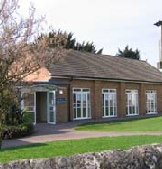A Brief guide to St Mary The Virgin Sprotbrough
Sprotbrough is a Domesday Book village. Although there is no mention of a church in 1086 there can be little doubt that there was a place of worship here then. There is a Saxon inscribed stone built into the chancel outer wall, though this is of interest rather than evidence of an earlier church. It may be a fragment of a Saxon cross.
The present church is late Norman and was probably built around 1170. In the Norman era the parish was strategically situated at the junction of Mercia and Northumbria. Sprotbrough may have been one of a chain of "burhs" or defensive settlements designed to keep out the Viking marauders. The parish was probably formed around the year 1000 and was held at the time by a Mercian named Wulfric Spott or Sprott from whom it probably derived its name. After the Norman Conquest in 1066, Sprotbrough was given to Roger de Busli and then to Fulk de Lisours. Fulk's grand-
The original church was almost certainly small with two cells (nave and chancel). It was narrow, tall and only two thirds the present length with a small and probably square chancel. The design was typical of Saxon and some early Norman churches. Since its foundation it has been radically altered. Today only traces of the masonry of Albreda's church remain. They are situated between the arches of the first two bays in the nave arcades. The church as we see it today is essentially as it would have been around 1520.





Need any help? Contact Us







Based at the heart of the community, available for hire, the hall is ideal for clubs/organisations as well as private functions,concerts, birthday parties, anniversaries, wedding reception, small exhibitions, and concerts.


A plaque over the north porch door gives the date of construction as 1632 and bears the names of the churchwardens of the day. The second name is Richard Foster but can you decipher the first?
The original nave was aisleless and extended only as far as the first two bays. It would have been like a tall rectangular box, dark and claustrophobic. The roof was steeply pitched with the nave walls the same height as today.
In 1516, the roof was replaced and clerestory windows inserted to give more light. The original roof line can be seen on the tower east wall. The nave, and recently built aisles, were extended westwards probably around 1360. The hatchment over the chancel arch displays the Royal Coat of Arms from the time of George 1 in 1714.
The present pulpit was reconstructed in 1915 using the panels and sounding board from the original "three decker" pulpit. The octagonal font is of the perpendicular period. The pew ends in the eastern nave come from the panels of box pews dismantled in 1915. Their fine carvings are said to be of 16th and 17th century origin. Those in the western nave are from the redundant church of St Peter in Old Edlington.
The tower was built when the nave was extended. The upper two stages were reconstructed around 1474 by the will of Sir William Fitzwilliam. The east opening of the tower was closed when the organ was added in the early 19th century.
Finely carved heads by the small door leading to the tower are said to represent St John and St Peter. The tower clock, was installed by Lady Gertrude Copley in memory of her husband Sir Godfrey (died 1709). The driving mechanism is now in the Horological Institute museum at Newark. The present peal of eight bells was hung in 1963 replacing the six peal from 1771.
Aisles
The south aisle contains St Thomas' chapel. It was constructed in the early to mid 14th century, doubtless for the Fitzwilliam family, who were "Lords of the Manor" The chapel contains a "squint" in the east wall. This enabled the priest to observe proceedings in the chancel during services. The chapel was refurbished in 1914 by Sir Ninian Comper whose mark, a small strawberry, can be seen low down in the right light of the Copley window.
During the work a lead coffin, probably that of Lady Isabel Deincourt (died 1348) was found under the broken medieval canopy on the north wall. The fine female effigy, said to be Lady Isabel, was originally under the ancient south wall "ogee" canopy. It was later re-
The inscribed medieval stone altar slab was recovered from the tower and placed in the chapel in 1963. Construction of the north aisle soon followed the south. It is interesting to note the semicircular responds on the east and west walls and the late Norman style capital in the eastern arcade bay. These probably came from the original chancel arch and date the church to around 1170. Two fine windows dedicated to former parishioners have recently been added to the aisles.
The chancel
Entry to the chancel is through the fine medieval screen. Built into the screen are several misericords on which the clergy sat during a long service. The chancel was added in the late 13th century. The arch, north and south windows and the fine triple sedilia and piscina are of that period (late Early English). The great east window is in the Tudor style. On the wall is an outline of an earlier window, probably the original, which was replaced when the roof was lowered. The glass in the upper lights of the north east window is said to be ancient.
On the floor of the chancel is a superb enclosed brass which commemorates Sir William Fitzwilliam (died 1474) and wife Elizabeth. A further fine brass commemorating Thomas Maulyverer, a former rector, is by the south wall near to the altar rail. The elevated tomb of Philip, the first Sprotbrough Copley, and his wife is built into the south wall. Next to his tomb is the church's oldest floor slab. It commemorates a former rector Thomas Fitzwilliam (died 1482). The carving is of a robed pre-
The Vestry (6)
This is of ashlar (faced masonry). It was probably built in the 15th century and may have replaced an earlier vestry. There are two floors, the lower of which is said to have been a chapel dedicated to St Nicholas. As part of the millennium alterations it was linked to the north aisle providing welcome new domestic facilities.
The South Porch

The age of the south porch is unknown, but it looks to be earlier than the north porch. Over the west window is an interesting roughly hewn lintel, reminiscent of crude Saxon work.
Outside the church

The external masonry varies from coursed rubble to ashlar. This, together with varying plinth heights and other characters, indicates the many alterations to the church. On the east wall of the tower, the 12th century roof line can be seen as an inverted V shape. This is preserved within the 1474 reconstruction of the upper stages. The west tower doorway is mid 14th century "ogee" style. A fine sundial of unknown antiquity may be seen on the south wall. The previously mentioned carved Saxon stone is situated low on the west buttress by the priest's door. Scratched into the face of the east buttress by the 'priest's door on the chancel south wall a badly worn mass dial can be seen. Being rough and ready sundials these are for obvious reasons always found on the south wall. They were used as a guide to service times and for his convenience were almost always situated by the priest's door.
Text by W.E. Rimington. (c)
More information about the church and interior can be found in the official guide book, which is available in the church.
The church is open daily from 9am to 5pm.
Please note, for security reasons the chancel is usually locked.

Social Media
Messy Church
St Mary’s
Our Facebook pages provide up to date information. Just click on the links above.
Join easyfundraising and you can collect free donations for us every time you buy something online. It won't cost you a penny extra so please help us to raise funds. CLICK on the above image.

Main St
Sprotbrough
Doncaster
Sth Yorkshire
DN5 7RF
Registered Charity Number 1133069
St Mary’s



Sprotbrough









Safeguarding
The Parish of Sprotbrough is committed to high standards in the safeguarding of children, young people and vulnerable adults. Our safeguarding officer is Janet Scott who can be contacted by email here, and our safeguarding policy can be viewed by following this link-
